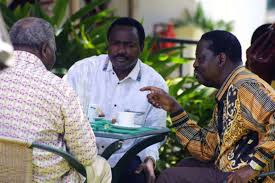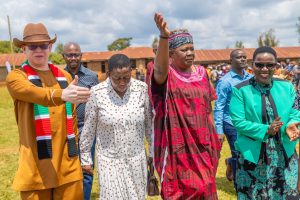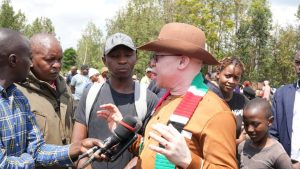By;Emmanuel Kyengo
Kenya’s political journey has long been defined by towering figures whose influence shaped the nation’s destiny.
The passing of Daniel arap Moi, Mwai Kibaki, and Raila Odinga marks the close of an extraordinary chapter — one characterized by struggle, resilience, and transformation.
Their deaths symbolize the end of an era and raise new questions about the country’s political future: does their legacy live on, and who will carry it forward?
The death of former President Daniel Toroitich arap Moi in February 2020 symbolized the fall of the old political order. Moi, who ruled from 1978 to 2002, personified post-independence politics.

His 24-year reign was marked by both stability and repression, during which the Kenya African National Union (KANU) maintained unchallenged dominance.
His passing signaled the curtain call on the one-party era, paving the way for a more open, competitive, and democratic political environment.
Two years later, in April 2022, Kenya bade farewell to its third President, Mwai Kibaki — widely regarded as “the economist” and credited with rebuilding the nation’s economy.
Kibaki’s leadership from 2002 to 2013 ushered in an era of recovery and expansion. He introduced free primary education and spearheaded major infrastructure projects such as the Thika Superhighway, transforming Kenya into one of Africa’s emerging economies.
His administration emphasized results over rhetoric, though his tenure was tested by the 2007 post-election crisis that challenged national unity.
Kibaki’s death marked the end of an era defined by technocratic governance and economic discipline.
The passing of Raila Amollo Odinga has also marked the end of Kenya’s liberation generation.

A long-time opposition leader, Raila embodied the spirit of defiance and reform. From his detention during the Moi era to his central role in the push for multiparty democracy and constitutional change, he became the face of political struggle and the voice of the marginalized.
His influence transcended politics — he represented a movement of the people. Raila’s death left a vacuum not easily filled, closing the chapter on a generation that defined modern Kenyan democracy.
Kitutu Chache MP Anthony Kibagendi has since defended Raila’s legacy, saying the former Prime Minister was unfairly labeled as stingy, insisting that he was, in fact, a generous and selfless leader.
As Kenya’s political landscape undergoes rapid transition, one man remains at the heart of this shift — Stephen Kalonzo Musyoka.
A veteran statesman, former Vice President, and respected peace negotiator, Kalonzo now stands as both a bridge between Kenya’s past political titans and a mentor urging a new generation to rise.
Having served as Vice President under President Kibaki between 2008 and 2013, Kalonzo earned a reputation for diplomacy, composure, and national balance during turbulent political times.
He later joined hands with Raila Odinga as his running mate in the 2013 and 2017 general elections, cementing his status as one of Kenya’s most consistent coalition builders.
With the departure of Moi, Kibaki, and Raila, Kalonzo finds himself stepping into a renewed role — that of a political elder and reform advocate.
Recent reports suggest that the government has reached out to him to join its ranks, but he has maintained that he remains firmly in the united opposition. “I cannot betray Kenyans, especially the young people who are yearning for change,” he said.
In recent weeks, Kalonzo has made spirited appeals to Kenya’s youth, urging them to rise above complacency and take charge of their destiny.
“The youth must not wait for change — they must be the change,” Kalonzo declared during a public engagement in Machakos. “This is the time for young leaders to rise, speak boldly, and join the movement that stands for stability and truth.”
His remarks, directed at outspoken young leaders such as Babu Owino and Edwin Sifuna, were both a challenge and an invitation — a call to rally around the Wiper Democratic Movement, which he describes as “a clean, reform-driven platform grounded in integrity and national unity.”
Beyond politics, Kalonzo’s image as a diplomat continues to shape his leadership style. His work in regional peace processes — from South Sudan to the Democratic Republic of Congo — has earned him respect across borders. To his allies, this experience lends him credibility as Kenya seeks unity amid shifting political alliances.
As the nation moves into a new political phase dominated by youthful leaders and dynamic alliances, Kalonzo’s message resonates — that Kenya’s next chapter must be built not on confrontation, but on character.
“Leadership is not about who shouts the loudest,” Kalonzo told supporters in Kitui. “It’s about who can listen, build bridges, and lead with humility.”
Often underestimated in the country’s high-stakes political arena, Kalonzo’s calm persistence may prove to be his greatest strength.
In a nation searching for balance between youthful energy and seasoned experience, his steady hand could shape the rhythm of Kenya’s next political chapter.
With the passing of Moi, Kibaki, and Raila, Kenya stands at a crossroads. The generation that fought for democracy and reform has given way to a younger, social media-driven class of leaders.
The question now is whether this new leadership will build on the values of integrity, service, and unity that defined those who came before.
The deaths of these iconic leaders closed powerful chapters in Kenya’s history — but they also opened a new page in its democratic journey, one that will test the nation’s readiness for a future without its founding giants.






More Stories
Jiji Launches Free “Zero to Profit” Course to Empower Young Entrepreneurs
PS Salome Muhia Calls for Public Support as Government Deepens Citizen Engagement
Ignore Propaganda, Support President’s Agenda — Mwaura Tells Mount Kenya